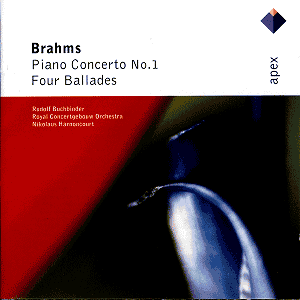This disc was originally issued on Teldec as
a double pack with the second concerto as coupling, and as a performance
seemed to fairly and squarely divide opinion. It’s easy to see
why. On first hearing, I was firmly in the camp that found the
reading ponderous and uneventful, with a lack of dramatic impetus
and rather four-square phrasing, despite good things along the
way. As is the way with these things, familiarisation after a
few more hearings has altered my judgement.
There is no doubt that Harnoncourt sets a very
spacious tempo for the massive opening movement (certainly slower
than the suggested dotted minim=58), putting a good two and a
half minutes on Haitink/Ashkenazy’s already grand account on Decca
(with the same orchestra). But I slowly began to realise that
this was paying dividends in certain areas. Woodwind detail is
exquisite (as at track1, 9’03) and those huge trills that permeate
the movement come at you like a whirlwind. I have a suspicion
that the development section is speeded up a fraction (12’03),
but this is ‘live’, so the frisson created here is quite
tangible. Buchbinder is a supremely intelligent artist (I have
long admired his Teldec disc of late Beethoven sonatas) and his
playing goes a long way towards the success of the disc. The solo
cadenza at 7’54 is beautifully shaped, and the way he and the
conductor handle the famous ‘wrong key’ recapitulation at 15’23
is really rather inspired, subtle rather than in neon lights.
The following movements go without much of a
hitch. The lovely slow movement is allowed to breathe and unfold
very naturally, and a steady but sharply etched reading of the
finale gives great satisfaction. The superb Concertgebouw strings
deliciously point the little fugato at 5’20, and the passage marked
quasi fantasia (8’15) has exactly the right amount of just that
– imaginative fantasy. The piano is beautifully caught throughout
by the engineers (something that cannot be said of the Decca disc),
and audience noise is remarkably low.
Competition is very fierce in this piece – I
myself have six or seven performances, so maybe the very low price
and addition of a coupling will sway collectors, though it has
to be said that rival discs offer the same pieces. The most famous
of these is undoubtedly the Gilels/Jochum DG disc, which is in
a slightly higher price category and in analogue sound, but sounds
well and offers supreme artistry, not least in the four lovely
Ballades, which Gilels seemed to make his own. Buchbinder is every
bit as sensitive to the nuances, both harmonic and atmospheric,
and though he may not be quite as volatile as the Russian, his
are very musical and satisfying readings. He also has superior
sound quality, this time in the studio.
It may be a case here of try before you buy,
but should you take the plunge (and it is, after all, less than
a fiver) you can rest assured you will get musicianship of a thrilling
order.
Tony Haywood
